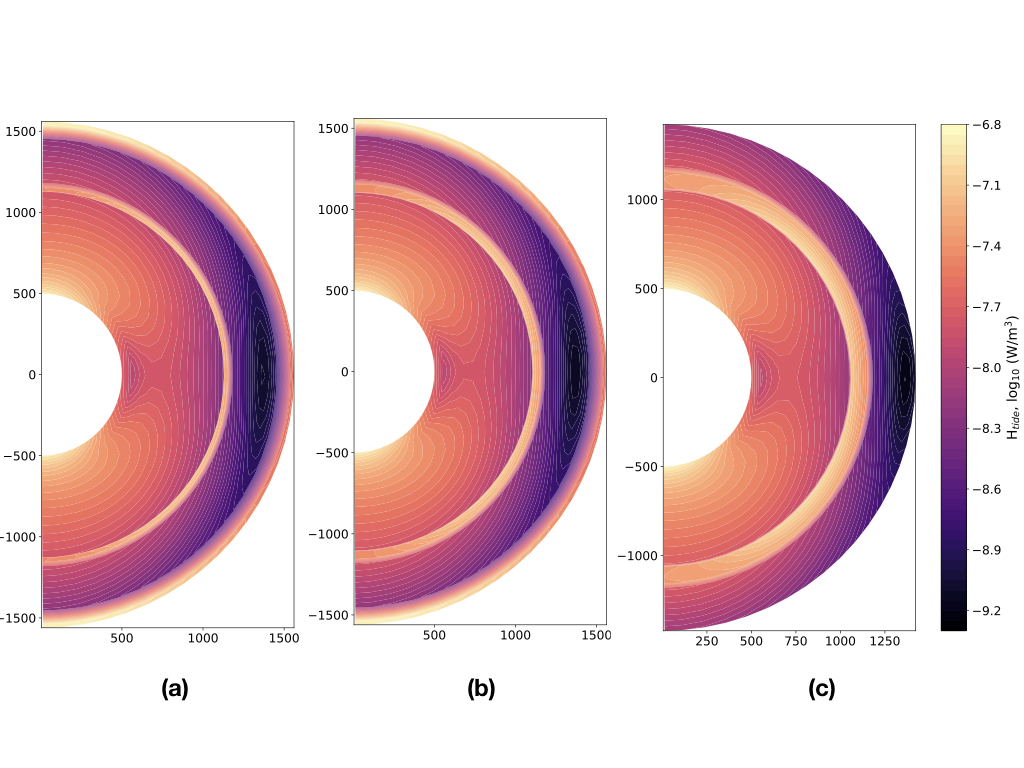Impact of partial melting on tidal dissipation in Europa's silicate mantle
- 1Université de Nantes, Laboratoire de Planétologie et de Géodynamique, Sciences de la Terre et de l'Univers, nantes, France (mathilde.kervazo@univ-nantes.fr)
- 2Charles University, Prague, Czech Republic
The presence of a subsurface ocean on Europa [1] in direct contact with the silicate mantle, along with the spectacular volcanic activity exhibited by its neighboring satellite Io [2] raise the possibility of seafloor volcanic activity [3,4], which has significant implications for Europa’s ocean habitability.
Observational constraints concerning the heat budget of Jupiter’s moons exist only for Io. The total power emitted at its surface is estimated to about 100 TW at present [5], which is several orders of magnitude higher than can be explained by radiogenic heating alone. Tidal dissipation in a partially molten layer at the top of the silicate mantle appears consistent with the prodigious heat flux emitted from Io [6,7], but it is still unclear how Io reached such a highly dissipative state.
Unlike Io, the heat flux at the surface of Europa’s rock mantle is unknown. Due to a larger distance from Jupiter and a smaller size, dissipation in Europa's mantle is expected to be considerably smaller than on Io [8], but still could be comparable to present-day radiogenic heating [4]. From 3D models, we recently showed that combined radiogenic heating and tidal heating can sustain partial melting in Europa's mantle during billions of years [4], especially during periods of enhanced eccentricity, which may lead to melt accumulation in the asthenosphere. Even if the melt production in Europa’s mantle is much smaller than Io’s, evaluating the coupling between melt generation and tidal heat production is essential to assess the extent of seafloor volcanism on Europa.
In the present study, we follow the approach developed to model the solid tides in Io’s partially molten interior [7], and adapt it to the context of Europa, corresponding to a deeper asthenosphere than on Io with presumably a smaller amount of melt present. We test the influence of partially molten zones on the tidal dissipation rate in Europa’s mantle (Figure 1), assuming rheological laws including the effect of melt on anelastic properties of rocks. Using the 3D model prediction of Běhounková et al. [4] for melt production, we estimate the effect of melt accumulation in Europa’s mantle on local dissipation rate and re-assess the consequences in terms of melt production rate. We investigate different scenarios for the eccentricity evolution and provide upper limits in terms of global power generated by tidal heating in Europa’s mantle through its evolution.

Figure 1: Spatial distribution of the averaged volumetric heating rate in Europa’s mantle including a 25 (a), a 50 (b) and a 100-km thick (c) partially molten layer with a melt fraction of 20%.
[1] Khurana, KK., et al., Nature, Vol. 395, pp. 777 (1998).
[2] Lopes, R. M., and Williams, D. A., Io after Galileo. Reports on Progress in Physics, 68(2), 303 (2005).
[3] Thomsom, R. and Delaney, J., JGR: Planets, Vol. 106, pp. 12355-12365 (2001).
[4] Běhounková et al., GRL, (2021).
[5] Veeder, G. et al., JGR: Planets, Vol. 99, pp. 17095-17162 (1994).
[6] Segatz, M. et al., Icarus, Vol. 75, pp 187-206 (1988).
[7] Kervazo et al., A&A, (2021).
[8] Tobie, G. et al., Icarus, Vol. 177, pp. 534-549 (2005).
Acknowledgements: This research received funding from the French “Agence Nationale de Recherche” A.N.R. (OASIS project, ANR-16-CE31-0023-01,( G.T., G.C., M.K., C.D.), from CNES (JUICE and Europa Clipper missions, G.T., G.C., M.K., C.D.) and from Czech Science Foun- dation through project No. 19-10809S (M.B.)
How to cite: Kervazo, M., Běhounková, M., Tobie, G., Choblet, G., and Dumoulin, C.: Impact of partial melting on tidal dissipation in Europa's silicate mantle , European Planetary Science Congress 2021, online, 13–24 Sep 2021, EPSC2021-274, https://doi.org/10.5194/epsc2021-274, 2021.

